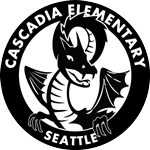Summer Readiness Grades 2-5
Dragons Read
Summer Reading Ideas from Our Librarian
2nd Grade Summer Readiness
Reading/Writing:
Set aside at least 20 minutes each day for your child to read on their own.
Have your child start to read chapter books and interesting non-fiction books with longer passages. Students entering the 2nd grade at Cascadia are typically reading at between level N and T.
Ask your child to describe the setting and plot, identify feelings and wants, and tell you some interesting facts they learn from books. Encourage curiosity and reflection over speed and memorization.
Math and Number Sense:
Help your child identify place value up to 7 digits (to 1 million)
Use real-life situations to familiarize your child with basic multiplication facts
Practice multi-digit addition and subtraction problems with regrouping (carrying/borrowing) up to 4 digits
Use stories to help show your child how to subtract across zeros
Model using rounding and estimation in real-life situations, such as a party or trip planning, to solve problems using mental math
Summer Math Learning Packet for 2nd Grade
Social/Emotional Learning Practices:
Help your child to recognize and name emotions in self/others
Practice calm-down strategies and expressing strong negative feelings with words rather than by acting out
Develop Independence
- Practice tying shoelaces, zipping and buttoning prior to start of school
- Teach your child to organize clothing, books, and other items in their room and in shared spaces. Help them to place items in cubbies, notebooks in desk, papers in folders, and trash/recycling in correct bins
- Help your child track their belongings, hang up jackets, put away shoes, etc. — this will help them take responsibility for items that regularly travel between school and home.
- Have your child’s items labeled
- Practice regular hand washing, covering mouths with elbow when sneezing or coughing and other health routines
3rd Grade Summer Readiness
- Addition and subtraction up to 4 digits.
- Create practice problems to review with your child that include regrouping and borrowing.
- Adding and subtracting decimals to two places, practice with money.
- Math Facts: Memorize ‘times 12’ tables and the corresponding division facts.
- Multiplication up to 2 by 2 digit.
- 20 minutes of daily reading (age appropriate and reading level appropriate)
4th Grade
Reading and Writing
- Read for at least 30 minutes silently uninterrupted
- Be comfortable and confident reading a wide variety of chapter books including realistic fiction, historical fiction, fantasy, science fiction, and non-fiction.
- Be able to provide and accurate retell of the events in text
- Have a firm grasp on writing conventions such as capitalization of proper nouns and punctuation
- Write at least a four-paragraph essay with four sentences per paragraph.
- Essays should have an introductory paragraph, two body paragraphs, and a concluding paragraph
- Be comfortable re-reading, revising, and editing first drafts of writing
- Be open to suggestions from peers and teacher on ways to improve writing
- Practice typing, working on using the proper finger placement on a QWERTY keyboard.
Math
- Fluency in addition and subtraction of fractions
- Fluency of multiplication and division facts 1-12
- Exposure to multiplication and division of fractions
- Division with 2-digit divisors
- Operation with decimals to the hundredths
- Exposure to area and volume
5th Grade Summer Readiness
Fraction Fluency
- Common Denominator and identifying like fractions and simplifying fractions
- Converting between mixed numbers and improper fractions and back again
- Adding, subtracting, multiplying and dividing fractions
- Multiplying two-digit by two-digit numbers
- Dividing three-digit by two-digit numbers
- Measures of Center
- Mean, median and mode
- Converting measurements within a system. IE standard units or metric
- Classify two-dimensional figures
- Find surface area and linear measurements
- Coordinate plan understanding and how to use ordered pairs
- 20 minutes of daily reading (age appropriate and reading level appropriate)
